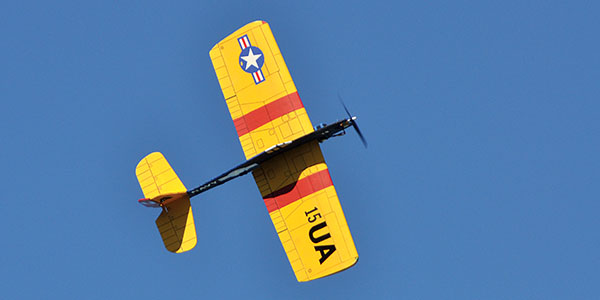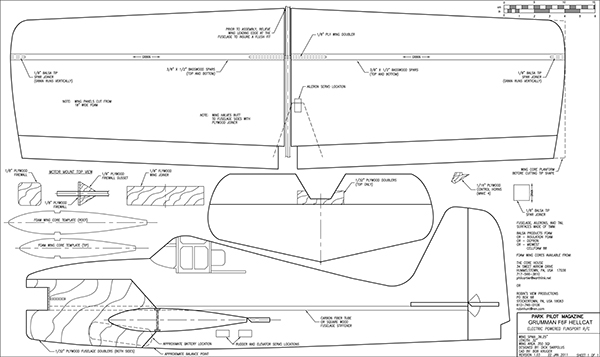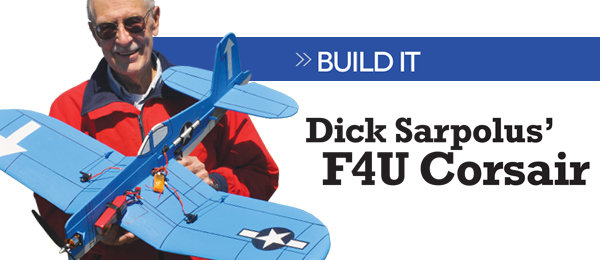
Designed by Dick Sarpolus. Free plans from Spring 2011 Park Pilot.
If you’re already flying electric-powered foamies in nearby parks and ball fields, you already know how much fun they are. Building your own airframes from sheet foam, thin plywood and fiberglass tubing will put you in the building part of the hobby, then you can have airplanes that are different from the cookie-cutters at the flying fields. Sheet-foam airframes are low cost, fairly rugged and easily repaired, and they provide a lot of flying fun for a relatively small investment in time and materials. Full-size plans for this F6F Hellcat and my Fw-190 (Summer 2010 Park Pilot) can be downloaded free of charge at www.theparkpilot.org. As I noted in the Fw-190 article, you can model almost any airplane you want by changing the outlines of the fuselage, wing and tail surfaces, while keeping the overall proportions of a model that you already know is a good flyer. The Grumman F6F Hellcat presented here is roughly the same overall size and proportions of the flat-foam Fw-190, but there’s one significant change: rather than using a flat, sheet-foam wing, the Hellcat uses a cut-foam wing with a thick airfoil. Flat-plate wing airplanes fly fine at slower speeds and under fairly calm air conditions in the restricted spaces of many of our park flying areas, but if we have the luxury of larger flying areas and want to fly in stronger wind conditions, the thick, airfoil wing can do a better job. The Hellcat isn’t a super-light, super-slow flyer and it’s not a 3-D machine; it’s a parkie, but on the larger and heavier side, and it can burn up a lot of sky. In addition to ball fields, we fly the F6F at an AMA club field along with larger, engine-powered airplanes. It fits right in. The Hellcat is a hybrid. It uses the simple, low-cost sheet foam for the profile fuselage and tail surfaces, along with a cut-foam wing core. Don’t worry. You won’t have to cut your own foam wing because it’s available at a pretty low cost. Phil Cartier at the Core House has a computerized hot-wire cutting setup. Because of his equipment and shipping methods, he cuts the cores to a length of 24 inches, so the builder just trims the cores at the tips for the span he wants, and trims the tips to any shape he wants. Read about the entire build process in the Spring 2011 issue of Park Pilot.

The Hellcat uses special cut-foam wing cores, and flat parts cut from sheet foam and plywood.

The primary difference between Dick Sarpolus’ Fw-190 and F6F Hellcat designs is in the wings. The Fw-190 has a flat-foam wing, and the Hellcat uses a cut-foam wing with a thick airfoil. The airfoil wing lets the Hellcat handle higher winds and greater flying speeds.

The strip ailerons are both driven by one central servo. Slot the fuselage for the aileron linkage to both sides. Glue plywood horns into both ailerons.

Here’s a detail view of the plywood elevator horn epoxied into the elevator, and the wire pushrod.
The airplane modeled here is the well known World War II Grumman F6F Hellcat, which gave outstanding service from our aircraft carriers in the Pacific. While not exactly scale, the outlines are close. The model won’t be mistaken for anything else, and that’s near enough to scale for me. Most Hellcats were painted navy Blue, but I wanted a paint scheme that would be more interesting. I found information on the many Hellcats used as unmanned target drones after the war. Most of these were painted all red, but the flying drone controller aircraft sometimes had the neat paint scheme I was looking for, with yellow wings and tail surfaces. This F6F won’t survive a 208-rocket barrage, but the plywood nose doublers and thick wing make it rugged enough that you won’t have to worry about every rough landing. If you’re an active RC hobbyist, you probably have most of the equipment for the model. You’ll need a brushless outrunner motor, an appropriate ESC, a 3S LiPo battery, a small 4-channel receiver and three small servos. This foamy is fun. Enjoy!

F6F Hellcat in flight.

One the U.S. Navy’s front-line World War II fighters is ready for you in this plans-built, profile project with a semi-symmetrical airfoil.

Hand-launch the F6F with an easy underhand toss at full throttle and it will climb right out of your hand.

Click here to download your free F6F Hellcat Build It Plans.
Article:





